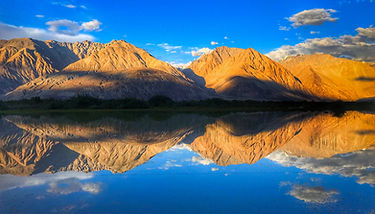
LADAKH
HOME / LADAKH
Top Destination In Ladakh
Ladakh is a mountainous region in South Asia. Due to its geographical and cultural similarity with Tibet, Ladakh is sometimes described as "Little Tibet". The rugged valleys and mountains , winding roads coupled with the vibrant cultural life maintain the exuberance and charm of this region . The magic of Leh will beckon you year after year and leave you still wanting more. The moonlike landscapes desert mountains and splashes of green and snow peaks , monasteries and stupas make you feel far removed from the world. The drive on mountain roads along the mighty Indus and Zanskar with grazing yaks , martens ,wild horses and sheep , apples and apricot trees are really like a dream come true.

Pangong Tso Lake
Pangong Lake, one of the most famous lakes in Leh Ladakh, derives its name from the Tibetan word, “Pangong Tso”, which means “high grassland lake”. Pangong Lake is an endorheic lake spanning eastern Ladakh and West Tibet situated at an elevation of 4,225 m. It is 134 km long and divided into five sublakes, called Pangong Tso

Khardung La
Khardung La or Khardung Pass is a mountain pass in the Leh district of the Indian union territory of Ladakh. The pass is on the Ladakh Range, north of Leh, and connects the Indus river valley and the Shyok river valley.

Magnetic Hill
Magnet Hill is a gravity hill located near Leh in Ladakh, India. The layout of the area and surrounding slopes create the optical illusion of a hill. The hill road is actually a downhill road. Objects and cars on the hill road may appear to roll uphill in defiance of gravity when they are, in fact, rolling downhill.

Nubra Valley
Nubra is a broad valley with lofty mountains on its all sides. Valley assumes greater attractions at the site where both the rivers meet. Nubra, also called Dumra, is a historical region of Ladakh, that is currently administered as a subdivision and a tehsil in the Leh district. Its inhabited areas form a tri-armed valley cut by the Nubra and Shyok rivers.

Sangam
Sangam is the confluence of Indus and Zanskar Rivers in Ladakh. It is located 35km from Leh in Nimmu, on the Leh Srinagar highway. Sangam of Indus and zanskar river at Nimmu is a place one shall never miss while on a trip to Leh. Watched greenish Indus and deep clear blue zanskar

Shanti Stupa
Built to promote world peace and prosperity as well as to commemorate 2500 years of Buddhism, Shanti Stupa is the major attraction in Leh Shanti Stupa is a Buddhist white-domed stupa on a hilltop in Chanspa, Leh district, Ladakh, in north India.

Tso Moriri Lake
Tso Moriri or Lake Moriri or "Mountain Lake", is a lake in the Changthang Plateau of Ladakh in India. The lake and surrounding area are protected as the Tso Moriri Wetland Conservation Reserve

Hall Of Fame
The Hall of Fame museum is located on the Leh-Kargil Road, about 4km from the city of Leh. It stands as a reminder of the great sacrifices made by our soldiersA museum worth a visit housing the history of the wars fought to drive away invaders seeking to conquer and add Ladakh to their territory.

Thikse Gompa
Thikse Gompa is a gompa affiliated with the Gelug sect of Tibetan Buddhism. It is noted for its resemblance to the Potala Palace in Lhasa, Tibet, and is the largest gompa in central Ladakh, notably containing a separate set of buildings for female renunciates that has been the source of significant recent building and reorganisation

Stok Palace
The palace of the banished royal family in Stok is now converted into a museum which displays the richest collection of jewellery, ornaments, Thangkas Built entirely by the Ladakhi craftsmen in 1820, the Stok Palace still continues to be a snug abode for the Namgyal dynasty. The 200-year old Stok Palace is an endearing landmark

Hemis Monastery
Hemis is a 17th century Buddhist shrine which was re-established in 1672 by the Ladakhi king Sengge Namgyal. Hemis Monastery is a Himalayan Buddhist monastery of the Drukpa Lineage, in Hemis, Ladakh, India. Situated 45 km from Leh.

White Water Rafting
White water river rafting in Ladakh is one of the most under appreciated activities in the region, but also one of the most adventurous.

 |
|---|
 |
 |
 |
 |
 |
 |
 |
 |
 |
 |
 |
 |
Essential Information
Language : Ladakhi, Hindi
Currency : INR
Best Time to Visit : April To September
Mode of Transport : Car, Public Transport
Known for : Natural Beauty
